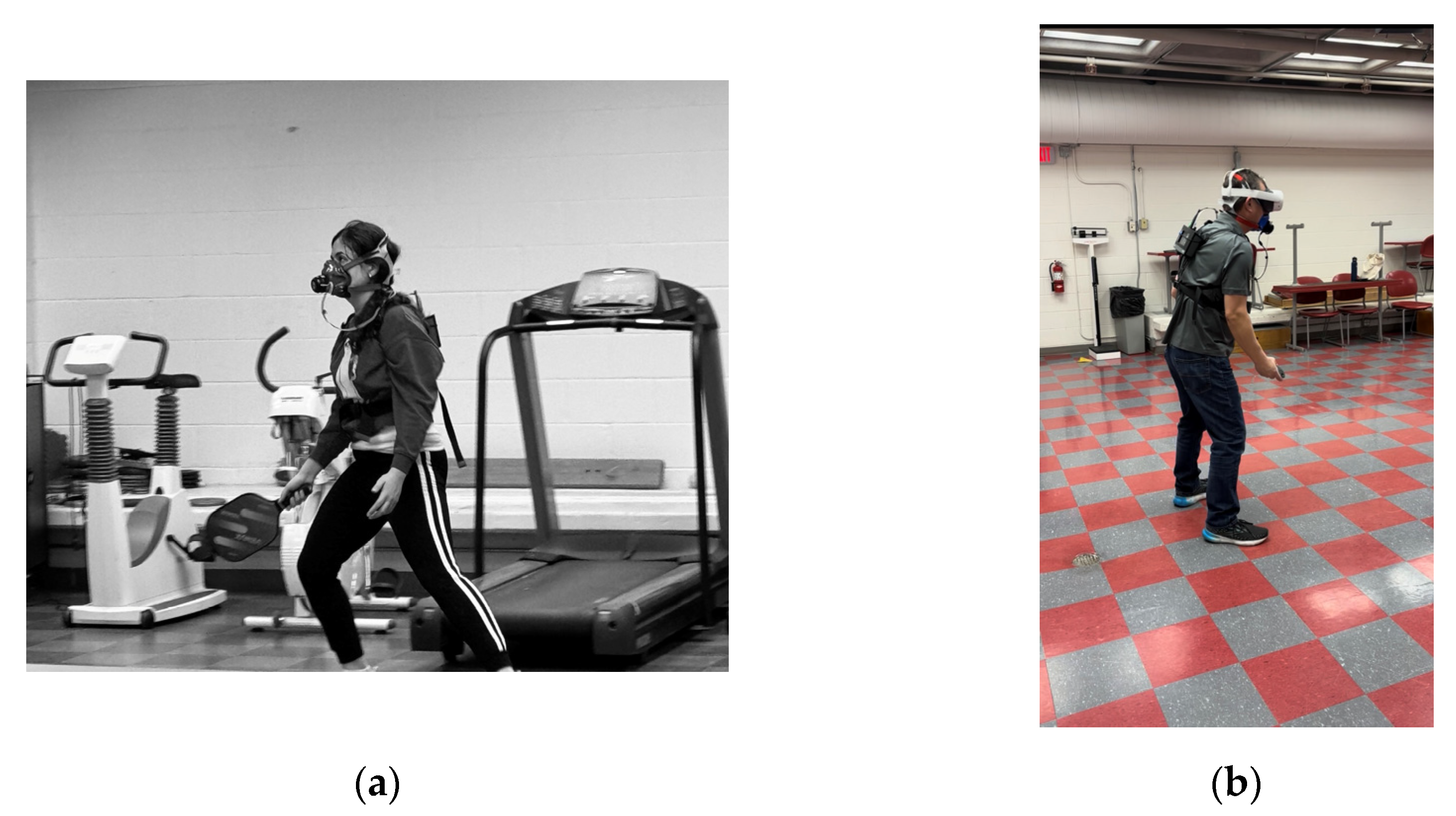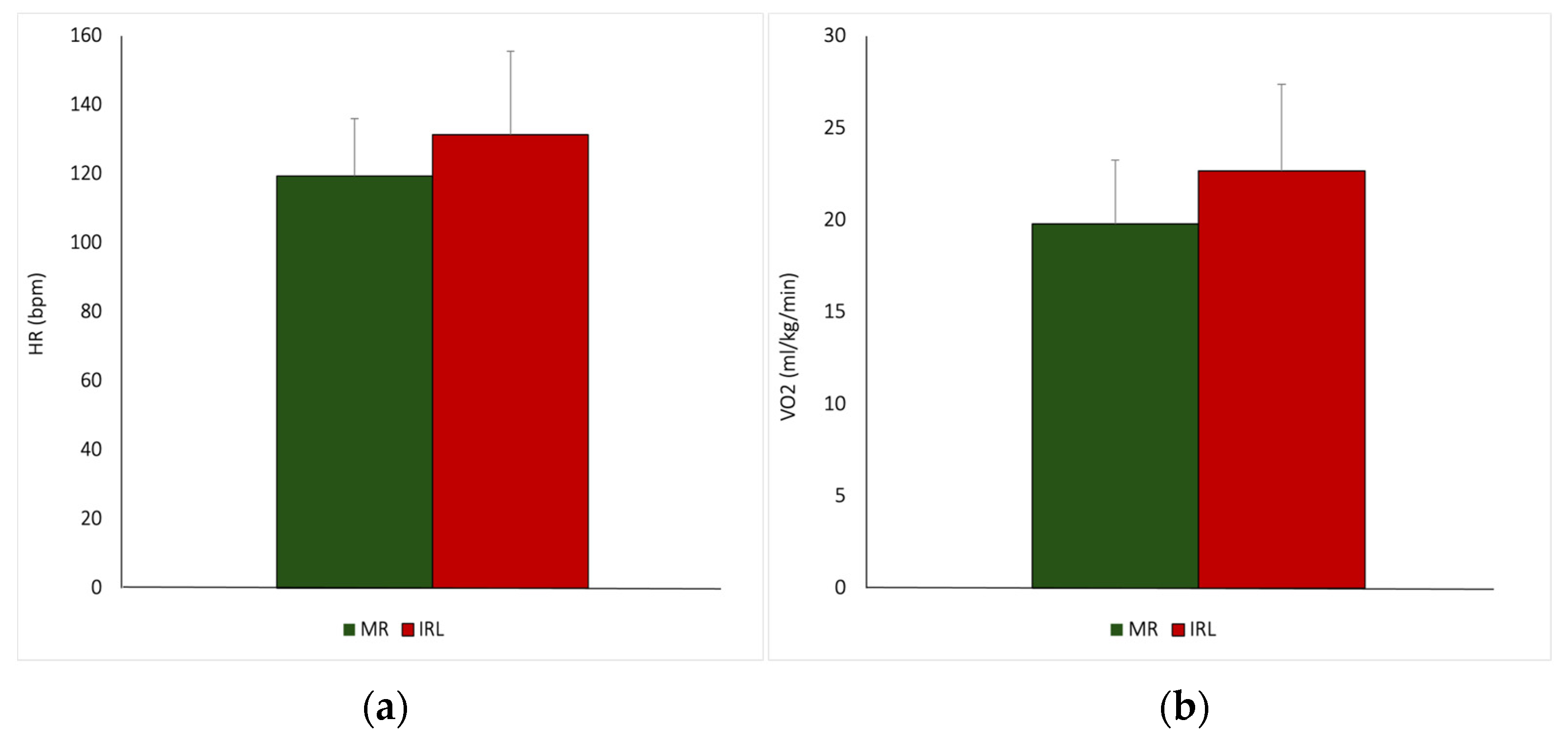Comparison of Metabolic and Pulmonary Variables Between Real-Life and Mixed Reality Pickleball
Abstract
1. Introduction
2. Materials and Methods
2.1. Participants
2.2. Protocol
2.3. Data Analysis
3. Results
- Heart rate and pulmonary measures.
| Pulmonary Measures and HR | MR | IRL | p | d |
|---|---|---|---|---|
| HR (bpm) | 119.38 ± 16.64 | 131.36 ± 24.21 | 0.002 | 1.12 |
| Rf (breath per minute) | 35.06 ± 5.28 | 37.85 ± 6.28 | 0.040 | 0.58 |
| VT (L) | 1.04 ± 0.17 | 1.15 ± 0.24 | 0.012 | 0.80 |
| VE (L/min) | 35.93 ± 6.95 | 43.05 ± 11.52 | 0.003 | 1.05 |
- Metabolic Measures
| Metabolic Measures | MR | IRL | p | d |
|---|---|---|---|---|
| RER | 0.80 ± 0.03 | 0.83 ± 0.03 | 0.01 | 0.84 |
| FAT (%) | 67.28 ± 11.76 | 55.66 ± 11.91 | 0.01 | 0.83 |
| CHO (%) | 32.72 ± 11.76 | 44.34 ± 11.91 | 0.01 | 0.84 |
| EE (Kcal) | 6.42 ± 1.53 | 7.26 ± 2.03 | 0.02 | 0.69 |
| VO2 (mL/kg/min) | 19.77 ± 3.47 | 22.68 ± 4.71 | 0.004 | 0.99 |
4. Discussion
5. Conclusions
Author Contributions
Funding
Institutional Review Board Statement
Informed Consent Statement
Data Availability Statement
Acknowledgments
Conflicts of Interest
Abbreviations
| MR | Mixed reality |
| IRL | In real life |
| HR | Heart rate |
| Rf | Respiratory frequency |
| VT | Tidal volume |
| VO2 | Volume of oxygen |
| VE | Ventilation |
| CHO% | Percentage of calories from carbohydrate |
| FAT% | Percentage of calories from fat |
| EE | Energy expenditure |
| RER | Respiratory exchange ratio |
References
- Safikhani, S.; Gattringer, V.; Schmied, M.; Pirker, J.; Wriessnegger, S.C. The Influence of Realism on the Sense of Presence in Virtual Reality: Neurophysiological Insights Using EEG. Multimodal Technol. Interact. 2024, 8, 104. [Google Scholar] [CrossRef]
- Brigham, T.J. Reality check: Basics of augmented, virtual, and mixed reality. Med. Ref. Serv. Q. 2017, 36, 171–178. [Google Scholar] [CrossRef] [PubMed]
- Qiao, Y.; Li, Y.; Zhang, T.; Liu, W. Never skip leg day again: Training the lower body with vertical jumps in a virtual reality exergame. arXiv 2023. [Google Scholar] [CrossRef]
- Tekerlek, H.; Yagli, N.V.; Saglam, M.; Cakmak, A.; Ozel, C.B.; Ulu, H.S.; Kutukcu, E.C.; Ince, D.I.; Arikan, H.; Coplu, L. Short-term effects of virtual reality and music with exercise training on affective responses and satisfaction level in patients with chronic respiratory disease. Eur. Respir. J. 2017, 50 (Suppl. 61), PA2537. [Google Scholar] [CrossRef]
- Rutkowski, S.; Szary, P.; Sacha, J.; Casaburi, R. Immersive virtual reality influences physiologic responses to submaximal exercise: A randomized, crossover trial. Front. Physiol. 2021, 12, 702266. [Google Scholar] [CrossRef]
- Ragan, E.D.; Sowndararajan, A.; Kopper, R.; Bowman, D.A. The effects of higher levels of immersion on procedure memorization performance and implications for educational virtual environments. Presence Teleoperators Virtual Environ. 2010, 19, 527–543. [Google Scholar] [CrossRef]
- Gao, Z.; Lee, J.E.; McDonough, D.J.; Albers, C. Virtual reality exercise as a coping strategy for health and wellness promotion in older adults during the COVID-19 pandemic. J. Clin. Med. 2020, 9, 1986. [Google Scholar] [CrossRef]
- McClure, E.A.; Schofield, G. Running virtual: The effect of virtual reality on exercise. J. Hum. Sport Exerc. 2020, 15, 866–871. [Google Scholar] [CrossRef]
- Annesi, J.J. Relationship between changes in acute exercise-induced feeling states, self-motivation, and adults’ adherence to moderate aerobic exercise. Percept. Mot. Ski. 2002, 94, 425–439. [Google Scholar] [CrossRef]
- Peng, W.; Crouse, J.C.; Lin, J.H. A meta-analysis of the effectiveness of digital games in increasing physical activity. Cyberpsychol. Behav. Soc. Netw. 2013, 16, 515–522. [Google Scholar] [CrossRef]
- Heydarian, A.; Carneiro, J.P.; Gerber, D.; Becerik-Gerber, B.; Hayes, T.; Wood, W. Immersive virtual environments versus physical built environments: A benchmarking study for building design and user–built environment explorations. Autom. Constr. 2015, 54, 116–126. [Google Scholar] [CrossRef]
- Statista. Virtual Reality (VR) Headsets—Worldwide Revenue. 2024. Available online: https://www.statista.com/outlook/cmo/consumer-electronics/gaming-equipment/vr-headsets/worldwide (accessed on 26 March 2025).
- Azar, F.; Lamplot, J.; Bernholt, D.; Spence, D. Pickleball: A standard review of injury prevalence and prevention in a rapidly growing sport. J. Am. Acad. Orthop. Surg. 2024, 32, e1130–e1141. [Google Scholar] [CrossRef] [PubMed]
- USA Pickleball. SFIA Topline Report Tabs Pickleball as America’s Fastest-Growing Sport for Third Consecutive Year. 2024. Available online: https://usapickleball.org/news/sfia-topline-report-tabs-pickleball-as-americas-fastest-growing-sport/ (accessed on 26 March 2025).
- USA Pickleball. 2023 USA Pickleball Fact Sheet. 2023. Available online: https://www.usapickleball.org/docs/USA-Pickleball-Fact-Sheet-2023.pdf (accessed on 26 March 2025).
- Forrester, M.B. Pickleball-related injuries treated in emergency departments. J. Emerg. Med. 2020, 58, 275–279. [Google Scholar] [CrossRef] [PubMed]
- Giustino, V.; Figlioli, F.; Patti, A.; Vicari, D.S.S.; Alamia, G.; Palma, A.; Romualdo, C.-L.; Thomas, E.; Bianco, A. Injuries in padel players: What is known? A scoping review. Int. J. Sports Sci. Coach. 2023, 19, 1286–1295. [Google Scholar] [CrossRef]
- Buchanan, S.L.; Lance, C.D. The Acute and Chronic Physiological Responses to Pickleball in Middle-Aged and Older Adults. Int. J. Res. Exerc. Physiol. 2018, 13, 21–32. [Google Scholar]
- Webber, S.C.; Anderson, S.; Biccum, L.; Jin, S.; Khawashki, S.; Tittlemier, B.J. Physical Activity Intensity of Singles and Doubles Pickleball in Older Adults. J. Aging Phys. Act. 2022, 31, 365–370. [Google Scholar] [CrossRef]
- Barbour, B.; Sefton, L.; Bruce, R.M.; Valmaggia, L.; Runswick, O.R. Acute psychological and physiological benefits of exercising with virtual reality. PLoS ONE 2024, 19, e0314331. [Google Scholar] [CrossRef]
- Rubio-Arias, J.Á.; Verdejo-Herrero, A.; Andreu-Caravaca, L.; Ramos-Campo, D.J. Impact of immersive virtual reality games or traditional physical exercise on cardiovascular and autonomic responses, enjoyment and sleep quality: A randomized crossover study. Virtual Real. 2024, 28, 64. [Google Scholar] [CrossRef]
- Riebe, D.; Franklin, B.A.; Thompson, P.D.; Garber, C.E.; Whitfield, G.P.; Magal, M.; Pescatello, L.S. Updating ACSM’s recommendations for exercise preparticipation health screening. Med. Sci. Sports Exerc. 2015, 47, 2473–2479. [Google Scholar] [CrossRef]
- Lakens, D. Calculating and Reporting Effect Sizes to Facilitate Cumulative Science: A Practical Primer for t-Tests and ANOVAs. Front. Psychol. 2013, 4, 863. [Google Scholar] [CrossRef]
- Formenti, D.; Rossi, A.; Bongiovanni, T.; Campa, F.; Cavaggioni, L.; Alberti, G.; Trecroci, A. Effects of non-sport-specific versus sport-specific training on physical performance and perceptual response in young football players. Int. J. Environ. Res. Public Health 2021, 18, 1962. [Google Scholar] [CrossRef] [PubMed]
- American Heart Association. Exercise Standards for Testing and Training: A Statement for Healthcare Professionals from the American Heart Association. Circulation 2005, 111, 659–672. [Google Scholar] [CrossRef]
- Zarei, S.; Green, D.; Peck, M.; Perez, O.R. Comparison of energy expenditure during virtual reality exercise and outdoor exercise. Int. J. Exerc. Sci. Conf. Proc. 2024, 14, 126. [Google Scholar]
- Navalta, J.W.; Carrier, B.; Blank, M.; Zarei, S.; Davis, D.W.; Craig, M.; Perez, O.R.; Baca, J.; Sweder, T.S.; Carballo, T.; et al. Validity and Reliability of Wearable Technology Devices during Simulated Pickleball Game Play. Sports 2024, 12, 234. [Google Scholar] [CrossRef]
- Godfrey, C.A.; Oody, J.F.F.; Conger, S.A.; Steeves, J.A. Active virtual reality games: Comparing energy expenditure, game experience, and cybersickness to traditional gaming and exercise in youth aged 8–12. Games Health J. 2025, 14, 42–48. [Google Scholar] [CrossRef]
- Rutkowski, S. Pulmonary rehabilitation supplemented with virtual reality training improves physical fitness in COPD patients: Randomized controlled trial. Eur. Respir. J. Suppl. 2020, 58 (Suppl. 65), PA417. [Google Scholar] [CrossRef]
- Singh, D.K.A.; Rajaratnam, B.S.; Vijayakumar, V. Participating in a virtual reality balance exercise program can reduce risk and fear of falls: A six-week intervention among postmenopausal women. J. Bodyw. Mov. Ther. 2013, 17, 332–338. [Google Scholar] [CrossRef]
- Cariati, I.; Bonanni, R.; Cifelli, P.; D’Arcangelo, G.; Padua, E.; Annino, G.; Tancredi, V. Virtual reality and sports performance: A systematic review of randomized controlled trials exploring balance. Front. Sports Act Living 2025, 7, 1497161. [Google Scholar] [CrossRef] [PubMed] [PubMed Central]
- Greene, D.R.; Rougeau, K.M. Punching up the fun: A comparison of enjoyment and in-task valence in virtual reality boxing and treadmill running. Psychol. Int. 2024, 6, 842–854. [Google Scholar] [CrossRef]
- Trabanelli, S.; Akselrod, M.; Fellrath, J.; Vanoni, G.; Bertoni, T.; Serino, S.; Papadopoulou, G.; Born, M.; Girondini, M.; Ercolano, G.; et al. Neural anticipation of virtual infection triggers an immune response. Nat. Neurosci. 2025, 28, 1968–1977. [Google Scholar] [CrossRef]


Disclaimer/Publisher’s Note: The statements, opinions and data contained in all publications are solely those of the individual author(s) and contributor(s) and not of MDPI and/or the editor(s). MDPI and/or the editor(s) disclaim responsibility for any injury to people or property resulting from any ideas, methods, instructions or products referred to in the content. |
© 2025 by the authors. Licensee MDPI, Basel, Switzerland. This article is an open access article distributed under the terms and conditions of the Creative Commons Attribution (CC BY) license (https://creativecommons.org/licenses/by/4.0/).
Share and Cite
Zarei, S.; Blank, M.; Bovell, J.; Davis, D.W.; Baca, J.; Wong, M.W.H.; Abarbanel, B.; Navalta, J.W. Comparison of Metabolic and Pulmonary Variables Between Real-Life and Mixed Reality Pickleball. J. Funct. Morphol. Kinesiol. 2025, 10, 346. https://doi.org/10.3390/jfmk10030346
Zarei S, Blank M, Bovell J, Davis DW, Baca J, Wong MWH, Abarbanel B, Navalta JW. Comparison of Metabolic and Pulmonary Variables Between Real-Life and Mixed Reality Pickleball. Journal of Functional Morphology and Kinesiology. 2025; 10(3):346. https://doi.org/10.3390/jfmk10030346
Chicago/Turabian StyleZarei, Setareh, Matahn Blank, Jamaal Bovell, Dustin W. Davis, Jacob Baca, Michael W. H. Wong, Brett Abarbanel, and James W. Navalta. 2025. "Comparison of Metabolic and Pulmonary Variables Between Real-Life and Mixed Reality Pickleball" Journal of Functional Morphology and Kinesiology 10, no. 3: 346. https://doi.org/10.3390/jfmk10030346
APA StyleZarei, S., Blank, M., Bovell, J., Davis, D. W., Baca, J., Wong, M. W. H., Abarbanel, B., & Navalta, J. W. (2025). Comparison of Metabolic and Pulmonary Variables Between Real-Life and Mixed Reality Pickleball. Journal of Functional Morphology and Kinesiology, 10(3), 346. https://doi.org/10.3390/jfmk10030346







